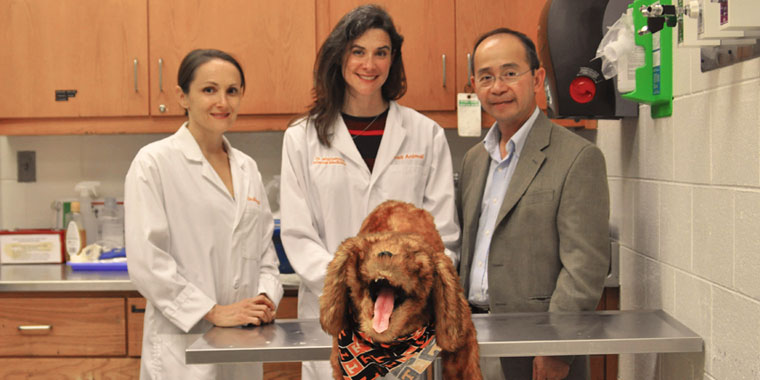Pets are a very important part of many people’s lives; and pet parents want their dogs to be healthy and receive the best veterinary care possible. A new technology developed at the University of Tennessee is helping to achieve this goal by training veterinarians with the latest in mannikin technology.
Meet FRED (the Flexible and Rigid Endoscopic Device), a K9 Endoscopy Mannikin invented by Dr. Jacqueline Whittemore, associate professor in Small Animal Clinical Sciences and a specialist in small animal medicine at the University of Tennessee Institute for Agriculture, and Dr. Katherine C. Kottkamp, DVM for the Regional Emergency Animal Care Hospital in Asheville, NC.

FRED was the first prototype of a lifelike canine mannikin used to teach flexible, upper gastrointestinal endoscopy to veterinarians. This technology developed at UT is currently licensed by the UT Research Foundation to Rescue Critters and marketed as Michael Angelo (Mikey). UTRF Licensing Associate, Nghia Chiem, Ph.D., worked closely with Drs. Whittemore and Kottkamp providing support and management throughout the commercialization process.

UTRF had the opportunity recently to speak with Dr. Kottkamp about their new technology.
What is your invention called and how does it work?
Our invention is called FRED which is an abbreviation for Flexible and Rigid Endoscopic Device. FRED is a simple, user friendly mannikin of a canine patient with a model gastrointestinal tract. FRED was developed to provide veterinary practitioners with a practical, simple, and affordable model to practice gastrointestinal and colonic endoscopy. FRED’s model GI tract accurately mimics the structure and orientation of the gastrointestinal tract of a live canine patient, with similar resistance and flexibility for realistic tactile feedback. FRED also has the potential to contain modules of the canine respiratory or urinary tract in the future to assist in practicing bronchoscopy and cystoscopy.
When/how did you come up with this idea?
As I was finishing up my fourth year of veterinary school, Dr. Whittemore and I met to discuss potential research projects. She said that she had always wanted to develop a model for endoscopy training. She felt that a simple, affordable model could be very valuable in the teaching setting and could be widely distributed to train veterinary practitioners. We started to discuss possible ways to construct a model and began work on a prototype. We met regularly for months to revise FRED and make modifications until we were satisfied with the result.
How will this invention affect veterinary medicine and the care of animals?
Gastrointestinal endoscopy is a valuable tool in everyday veterinary practice. It can be used to examine the GI tract, remove foreign material, and obtain biopsies without abdominal surgery. When veterinarians use these non-invasive techniques, patients experience less pain and recovery times are reduced. At this point, endoscopy is most commonly used in a specialty setting. FRED is a valuable training tool to help expand the number of veterinarians who are able to use endoscopy proficiently.
What benefit is this invention to the non-medical/scientific community of pet owners?
 Pet owners benefit when their family veterinarian is able to perform procedures in a way that minimizes pain and reduces complication rates and recovery times. FRED makes it possible to expand endoscopy training so that many more veterinarians can provide these valuable services to their clients. Pets, pet owners, and veterinarians all benefit when the number of practitioners who are proficient in endoscopy increases because quality of care increases as well.
Pet owners benefit when their family veterinarian is able to perform procedures in a way that minimizes pain and reduces complication rates and recovery times. FRED makes it possible to expand endoscopy training so that many more veterinarians can provide these valuable services to their clients. Pets, pet owners, and veterinarians all benefit when the number of practitioners who are proficient in endoscopy increases because quality of care increases as well.
See the technology in action.
Click to view videos.
